Veil of Veronica

The Veil of Veronica, or Sudarium (Latin for sweat-cloth), often called simply "The Veronica" and known in Italian as the Volto Santo or Holy Face (but not to be confused with the carved crucifix Volto Santo of Lucca), is a Christian relic of a piece of cloth which, according to tradition, bears the likeness of the face of Jesus not made by human hand (i.e. an Acheiropoieton). Various existing images have been claimed to be the "original" relic, or early copies of it.
The final form of the Western tradition recounts that Saint Veronica from Jerusalem encountered Jesus along the Via Dolorosa on the way to Calvary. When she paused to wipe the blood and sweat (Latin sudor) off his face with her veil, his image was imprinted on the cloth. The event is commemorated by the Sixth Station of the Cross. According to some versions, St. Veronica later traveled to Rome to present the cloth to the Roman Emperor Tiberius and the veil possessing the Grace of God, was able to quench thirst, cure blindness, and even raise the dead.
The story is not recorded in its present form until the Middle Ages. During the fourteenth century it became a central icon in the Western Church – in the words of art historian Neil Macgregor – “From [the 14th Century] on, wherever the Roman Church went, the Veronica would go with it.”[1] The act of Saint Veronica wiping the face of Jesus with her veil is celebrated in the sixth Station of the Cross in many Anglican, Catholic, Lutheran, Methodist and Western Orthodox churches.[2][3][4]

The story
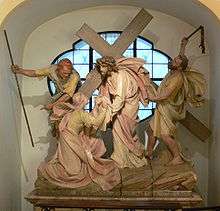
There is no reference to the story of Veronica and her veil in the canonical Gospels. The closest written reference is the miracle of Jesus healing the bleeding woman by touching the hem of Jesus’ garment (Luke 8:43-48); her name is later identified as Veronica by the apocryphal "Acts of Pilate". The story was later elaborated in the 11th century by adding that Christ gave her a portrait of himself on a cloth, with which she later cured Tiberius. The linking of this with the bearing of the cross in the Passion, and the miraculous appearance of the image was made by Roger d'Argenteuil's Bible in French in the 13th century,[5] and gained further popularity following the internationally popular work, Meditations on the Life of Christ of about 1300. It is also at this point that other depictions of the image change to include a crown of thorns, blood, and the expression of a man in pain,[6] and the image became very common throughout Catholic Europe, forming part of the Arma Christi, and with the meeting of Jesus and Veronica becoming one of the Stations of the Cross.
On the Via Dolorosa in Jerusalem there is a small chapel, known as the Chapel of the Holy Face.[7] Traditionally, this is regarded as the home of St Veronica and site of the miracle.[8]
According to the Catholic Encyclopedia, the name "Veronica" is a colloquial portmanteau of the Latin word vera, meaning truth, and Greek icon (eikon), meaning "image"; the Veil of Veronica was therefore largely regarded in medieval times as "the true image", and the truthful representation of Jesus, preceding the Shroud of Turin.[9]
History of the veil
There was a physical image displayed in Rome in the thirteenth, fourteenth and fifteenth centuries which was known and venerated as the Veil of Veronica. However, the history of that image is somewhat problematic.

It has often been assumed that the Veronica was present in the Old St Peter's in the papacy of John VII (705-8), as a chapel known as the Veronica chapel was built during his reign, and this seems to have been the assumption of later writers. However, this is far from certain, as mosaics which decorated that chapel do not refer to the Veronica story in any way. Furthermore, contemporaneous writers make no reference to the Veronica in this period. It would appear however that the Veronica was in place by 1011 when a scribe was identified as keeper of the cloth.[10]
Firm recording of the Veronica only begins in 1199 when two pilgrims named Gerald de Barri (Giraldus Cambrensis) and Gervase of Tilbury made two accounts at different times of a visit to Rome, making direct reference to the existence of the Veil of Veronica. Shortly after that, in 1207, the cloth became more prominent when it was publicly paraded and displayed by Pope Innocent III, who also granted indulgences to anyone praying before it. This parade, between St Peter's and the Santo Spirito Hospital, became an annual event and on one such occasion in 1300 Pope Boniface VIII, who had it translated to St. Peter's in 1297, was inspired to proclaim the first Jubilee in 1300. During this Jubilee the Veronica was publicly displayed and became one of the "Mirabilia Urbis" ("Wonders of the City") for the pilgrims who visited Rome. For the next two hundred years the Veronica, retained at Old St Peter's, was regarded as the most precious of all Christian relics; there Pedro Tafur, a Spanish visitor in 1436, noted:
On the right hand is a pillar as high as a small tower, and in it is the holy Veronica. When it is to be exhibited an opening is made in the roof of the church and a wooden chest or cradle is let down, in which are two clerics, and when they have descended, the chest or cradle is drawn up, and they, with the greatest reverence, take out the Veronica and show it to the people, who make concourse there upon the appointed day. It happens often that the worshippers are in danger of their lives, so many are they and so great is the press.Pedro Tafur, Andanças e viajes.
After the Sack of Rome in 1527, some writers recorded that the veil had been destroyed: Messer Unbano to the Duchess of Urbino say that the Veronica was stolen and passed around the taverns of Rome.[11] Other writers however, testify to its continuing presence in the Vatican and one witness to the sacking states that the Veronica was not found by the looters.[12]
Many artists of the time created reproductions of the Veronica, again suggesting its survival, but in 1616, Pope Paul V prohibited the manufacture of further copies unless made by a canon of Saint Peter's Basilica. In 1629, Pope Urban VIII not only prohibited reproductions of the Veronica from being made, but also ordered the destruction of all existing copies. His edict declared that anyone who had access to a copy must bring it to the Vatican, under penalty of excommunication.
After that the Veronica disappears almost entirely from public view, and its subsequent history is unrecorded. As there is no conclusive evidence that it ever left St Peter's, the possibility exists that it remains there to this day; this would be consistent with such limited information as the Vatican has provided in recent centuries.
Images traditionally connected with the Veil of Veronica
There are at least six images in existence which bear a marked resemblance to each other and which are claimed to be the original Veil, a direct copy of it or, in two cases, the Mandylion. Each member of this group is enclosed in an elaborate outer frame with a gilded metal sheet (or riza in Russian) within, in which is cut an aperture where the face appears; at the lower extreme of the face there are three points which correspond to the shape of the hair and beard.
- Veil of Veronica
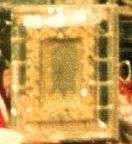 The Vatican Veronica.
The Vatican Veronica. The Holy Face of Vienna.
The Holy Face of Vienna. The Holy Face of Alicante.
The Holy Face of Alicante.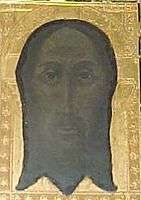 The Holy Face of Jaén.
The Holy Face of Jaén.
St. Peter's Basilica
There is an image kept in St Peter’s Basilica which purports to be the same veil as was revered in the Middle Ages. This image is stored in the chapel that lies behind the balcony in the southwest pier supporting the dome.
Very few inspections are recorded in modern times and there are no detailed photographs. The most detailed recorded inspection of the 20th century occurred in 1907 when Jesuit art historian Joseph Wilpert was allowed to remove two plates of glass to inspect the image. He commented that he saw only "a square piece of light coloured material, somewhat faded through age, which bear two faint rust-brown stains, connected one to the other".[13]
Nevertheless, the face is still displayed each year on the occasion of the 5th Sunday of Lent, Passion Sunday. The blessing takes place after the traditional Vespers at 5.00 pm. There is a short procession within the basilica, accompanied by the Roman litany. A bell rings and three canons carry the heavy frame out on the balcony above the statue of St. Veronica holding the veil.[14] From this limited view no image is discernible and it is only possible to see the shape of the inner frame.
The Hofburg Palace, Vienna
In the Hofburg Palace in Vienna there is a copy of the Veronica, identified by the signature of P. Strozzi in the right hand corner of the inner frame. He was the secretary of Pope Paul V, and a man referred to by Vatican notary Jacopo Grimaldi as making a series of six meticulous copies of the veil in 1617.[15]
The outside of the frame is relatively modern, while the inner frame is roughly made and corresponds to the cut-out pattern of earlier copies. The face within is very unclear, more a series of blotches in which only the bare elements of a nose, eyes and mouth can be identified. This argues for the authenticity of the copy as there is clearly no attempt at artistic enhancement. Furthermore, the fact of its being copied from the Vatican copy after the Sack of Rome in 1527 suggests that the original image may have survived that event.
It is kept in the Schatzkammer of Sacred and Secular Treasurers of the Habsburg dynasty in the Hofburg Palace, Vienna.
Monastery of the Holy Face, Alicante, Spain
This relic was acquired by Pope Nicholas V from relatives of the Byzantine Emperor in 1453. This veil was given by a Vatican cardinal to a Spanish priest, Mosen Pedro Mena, who took it to Alicante, in southern Spain, where it arrived in 1489, at the same time as a severe drought. Carried in a procession on 17 March by an Alicante priest, Father Villafranca, a tear sprang from the eye of the face of Christ on the veil and rain began to fall. The relic is now housed in the Monastery of the Holy Face (Monasterio de la Santa Faz), on the outskirts of Alicante, in a chapel built in 1611 and decorated between 1677 and 1680 by the sculptor José Vilanova, the gilder Pere Joan Valero and the painter Juan Conchillos. The chapel is decorated with paintings depicting the miraculous termination of the drought, local personalities associated with the founding of the chapel and religious themes of judgment and salvation. The Monastery was extensively restored between 2003-6, together with the Cathedral of Saint Nicholas and the Basilica of St Mary in the city centre, and the three buildings housed an exhibition in 2006 about the relic under the name of The Face of Eternity.[16]
Jaén Cathedral, Jaén, Spain
The cathedral of Jaén has a copy of the Veronica which probably dates from the fourteenth century and originates in Siena. It is kept in a shrine by the high altar and is annually exhibited to the people on Good Friday and on the Feast of the Assumption. It is exhibited in a chapel to the side of the Cathedral every Friday from 11.30 a.m. to 1 p.m. when visitors are allowed to kiss the glass that protects the image. Known as the Santo Rostro, it was acquired by Bishop Nicholas de Biedma in the 14th Century.[17]
Similar images
Holy Face of Genoa
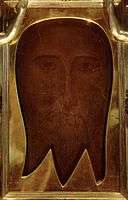
Kept in the modest Church of St Bartholomew of The Armenians, Genoa, it was given in the 14th century to the Doge Leonardo Montaldo by the Byzantine Emperor John V Palaeologus.
The image was studied in detail in 1969 by Colette Dufour Bozzo, who dated the outer frame to the late 14th Century,[18] while the inner frame and the image itself are believed to have originated earlier. Bozzo found that the image was imprinted on a cloth that had been pasted onto a wooden board.[19] The similarity of the image with the Veil of Veronica suggests a link between the two traditions.
Holy Face of S. Silvestro
This image was kept in Rome's church of S. Silvestro until 1870 and is now kept in the Matilda chapel in the Vatican. It is housed in a Baroque frame donated by one Sister Dionora Chiarucci in 1623.[20] The earliest evidence of its existence is 1517 when the nuns were forbidden to exhibit it to avoid competition with the Veronica. Like the Genoa image, it is painted on board and therefore is likely to be a copy.
It was exhibited at Germany's Expo 2000 in the pavilion of the Holy See.
The Manoppello Image

In 1999, German Jesuit Father Heinnrich Pfeiffer, Professor of Art History at the Pontifical Gregorian University,[21] announced at a press conference in Rome that he had found the Veil in a church of the Capuchin monastery, in the small village of Manoppello, Italy, where it had been since 1660. Professor Pfeiffer had, in fact, been promoting this image for many years before.[22] It is known as the Manoppello Image.
According to local tradition, an anonymous pilgrim arrived in 1508 with the cloth inside a wrapped package. The pilgrim gave it to Dr. Giacomo Antonio Leonelli, who was sitting on a bench in front of the church. The doctor went into the church and opened the parcel containing the Veil. At once, he went out of the church but did not find the bearer of the packet. The Veil was owned by the Leonelli family until 1608. Pancrazio Petrucci, a soldier married to Marzia Leonelli, stole the Veil from his father-in-law’s house. A few years later, Marzia sold it for 400 scudi to Doctor Donato Antonio De Fabritiis to pay a ransom demand for her husband who was then a prisoner in Chieti. The Veil was given by De Fabritiis to the Capuchins who still hold it today. This history was documented by Father Donato da Bomba in his “Relatione historica” following researches started in 1640.
Representative art

There are two main traditions for the iconography of the face depicted on the veil. One tradition (Type I), common in Italian art, shows the face of Christ as full-bearded, in pain, scourged and perhaps crowned with thorns. Another (Type II), common in Russian and Spanish art, shows Christ's face more often in repose, hair extending to shoulder length and a bifurcated beard, often surrounded by a halo quartered in a cross. Another (Type III), common in the Philippines shows Christ's face three times with hair down to the shoulder and with the Crown of Thorns.
- Type I
- Veronica's Veil Domenico Fetti, circa 1620.
- Holy Face Giambono, fifteenth century. Civic Museum, Pavia, Italy.
- Holy Face Held by Two Angels Juan Sánchez Cotan, 1620–1625. Monastery of Cartuja, Granada.
- Holy Face Domenikos Theotokopoulos (El Greco). Convent of Capuchin Nuns, Toledo.
- Veronica's Veil Francisco de Zurbarán, seventeenth century. Parish Church of St Peter, Seville.
- Type II
- Head of Christ on the Sudarium Claude Mellan, 1649.
- Diptych of Saint Veronica with Christ and the Virgin Mary Bernardo Martorelli, fifteenth century. Museum of Mallorca.
- Holy Face, anonymous, early 17th century. Tretyakov Gallery, Moscow.
- Holy Face Simon Ushakov, 1678. Tretyakov Gallery, Moscow.
- Miracle of the Tear Juan Conchillos, 1680. Lady Chapel of the Monastery of the Holy Face, Alicante.
- Miracle of the Three faces Juan de Miranda, 1767. Alicante Ayuntamiento.
- Saint Veronica Antonio Castillo Lastrucci, 1946. Basilica of St Mary, Alicante.
- Veil of Veronica in Art
 St Veronica with the Sudarium
St Veronica with the Sudarium The Veil of Veronica by the Master Of The Legend Of St. Ursula
The Veil of Veronica by the Master Of The Legend Of St. Ursula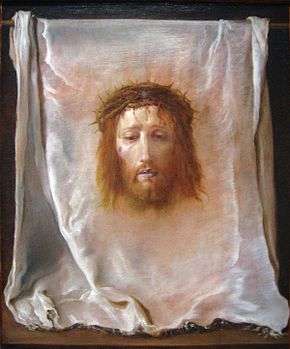 Domenico Fetti, The Veil of Veronica
Domenico Fetti, The Veil of Veronica St. Veronica with the Holy Kerchief
St. Veronica with the Holy Kerchief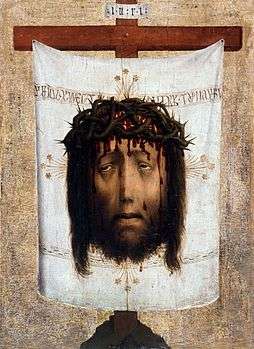 The veil of St. Veronica (Vera Icon), c. 1450
The veil of St. Veronica (Vera Icon), c. 1450 Head of Christ on the Sudarium, engraving by Claude Mellan (1649), a famous virtuoso piece consisting of a single line beginning on the tip of Christ's nose.
Head of Christ on the Sudarium, engraving by Claude Mellan (1649), a famous virtuoso piece consisting of a single line beginning on the tip of Christ's nose. The Veil of Veronica by Francisco de Zurbarán
The Veil of Veronica by Francisco de Zurbarán Image of the Saviour, a traditional Orthodox iconography in the interpretation of Simon Ushakov (1658).
Image of the Saviour, a traditional Orthodox iconography in the interpretation of Simon Ushakov (1658)._(Italian_-_Head_of_Christ_-_Google_Art_Project.jpg) Correggio, 1521
Correggio, 1521 St. Veronica with the Holy Kerchief, by Mattia Preti
St. Veronica with the Holy Kerchief, by Mattia Preti
See also
- Acheiropoieta
- Black Madonna of Częstochowa
- Image of Camuliana
- Image of Edessa
- Relics attributed to Jesus
- Shroud of Turin
- Sudarium of Oviedo
References
- ↑ ”Seeing Salvation” Images of Christ in Art, Neil MacGregor, ISBN 0-563-55111-9.
- ↑ "Stations of the Cross". Trinity UMC. 24 March 2013. Retrieved 25 April 2016.
This tradition began most prominently with St. Francis of Assisi (1182–1226) and spread to other churches in the medieval period. It is also observed by a growing number of Anglicans, Methodists, and Lutherans. It is most commonly done during Lent, especially on Good Friday.
- ↑ Vatican Website Sixth Station
- ↑ Religious Literacy (Stephen Prothero), HarperCollins Publishers, page 284
- ↑ G Schiller, Iconography of Christian Art, Vol. II,1972 (English trans from German), Lund Humphries, London, pp. 78–9, ISBN 0-85331-324-5
- ↑ G Schiller, op. & page cit
- ↑ "Via Dolorosa – Jerusalem". sacred-destinations.com.
- ↑ אתרים- קבצים
- ↑ "CATHOLIC ENCYCLOPEDIA: St. Veronica". newadvent.org.
- ↑ Ian Wilson, Holy Faces, Secret Places, page 175
- ↑ Ian Wilson, Holy Faces, Secret Places, page 112
- ↑ Ian Wilson, Holy Faces, Secret Places, page 113
- ↑ Ian Wilson, Holy Faces, Secret Places, page 63
- ↑ "The Holy Veil of St. Veronica". flickr. Yahoo Co. Retrieved 25 September 2014.
- ↑ Ian Wilson, Holy Faces, Secret Places, page 157
- ↑ Visitor's Guide to the Exposición La Luz de las Imagenes – La Faz de la Eternidad, Alicante 2006.
- ↑ Ian Wilson, Holy Faces, Secret Places, page 94
- ↑ Ian Wilson, Holy Faces, Secret Places, page 162
- ↑ Wilson, ibid, page 88
- ↑ Ian Wilson, Holy Faces, Secret Places, page 193
- ↑ http://holyfaceofmanoppello.blogspot.com/2008/05/fr-heinrich-pfeiffer-sj-teaches-about.html Excerpt of Il Volto Santo di Manoppello (The Holy Face of Manoppello), published by Carsa Edizioni in Pescara (page 13) access date March 2013
- ↑ Ian Wilson, Holy Faces, Secret Places, page 161
Further reading
- Bennett, Janice (2001). Sacred Blood, Sacred Image: The Sudarium of Oviedo, New Evidence for the Authenticity of the Shroud of Turin. San Francisco: Ignatius Press. ISBN 0-9705682-0-7.
- Joan Carroll Cruz, OCDS, Miraculous Images of Our Lord. ISBN 0-89555-496-8
- Ewa Kuryluk, Veronica and Her Cloth: History, Symbolism, and Structure of a True Image. ISBN 0-631-17813-9
- Ian Wilson, Holy Faces, Secret Places,Corgi, ISBN 0-552-13590-9
External links
| Look up vernicle in Wiktionary, the free dictionary. |
| Wikimedia Commons has media related to Veil of Veronica. |
- The New Schaff-Herzog Encyclopedia of Religious Knowledge
- "St. Veronica and the Volto Santo"
- official website of Capuchin Friars of Manoppello
- St. Veronica in St. Peter's
- "German website Volto-Santo.com"
- "Polish website Volto Santo di Manoppello"
- "English version of Polish website Volto Santo di Manoppello"
- Sudarium Christi The Face of Christ online audio visual featuring texts by sudarium expert Sr. Blandina Paschalis Schlömer et al.
- The Rediscovered Face – 1 first of four installments of an audiovisual presentation relating the holy image with a number of ancient predecessors, YouTube, access date March 2013.